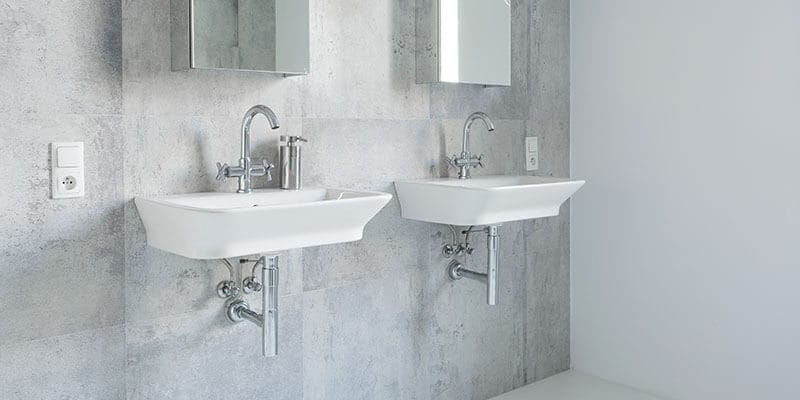Proper height of a bathroom sink is crucial for a comfortable usage experience, whether you are washing hands, brushing teeth, or leaning in for a closer look in the mirror. If the sink is too high, children may find it hard to reach, but if it’s too low, adults may need to stoop down to do their daily routine.
The standard height of a bathroom sink varies from 32 to 36 inches. However, the height may differ for other types of sinks, such as vessel sinks, pedestal sinks, and wall-mounted sinks. Let’s take a closer look at this post.
Key Takeaways
- Proper sink height enhances comfort and accessibility in the bathroom.
- Sink installation height varies with sink type and user needs.
- Considerations include ADA compliance and height adjustment options.
Standard Bathroom Sink Height
Countertop and Sink Measurements
standard height, which typically ranges from 32 to 36 inches from the floor to the top of the sink. For a standard sink, the average depth is about 8 inches, with a countertop height of 32 inches being common.
| Sink Type | Typical Height Range |
| Standard Sink | 32 to 36 inches |
| Vessel Sink | 30 to 36 inches |
| ADA Compliant | up to 34 inches |
Bathroom vanity height with a vessel sink might be lower to compensate for the additional height of the sink; the sink’s centerline should remain within the comfortable reach.
ADA Compliance
For a bathroom to be wheelchair accessible under the Americans with Disabilities Act (ADA), the sink height must not exceed 34 inches. This is measured from the floor to the top of the sink. The ADA requirements also stipulate sufficient clearance underneath the sink to allow for easy access by individuals using a wheelchair.
| ADA Requirement | Specification |
| Maximum Height | 34 inches |
| Under-sink Clearance | Wheelchair accessible |
Installation Considerations
When installing a bathroom sink, it’s essential to factor in both the plumbing requirements and ergonomic factors to ensure the sink functions properly and comfortably fits the users’ needs.
Plumbing Requirements
The installation of your bathroom sink is governed by specific plumbing requirements that must be met to ensure proper operation and code compliance. You need to be aware of the location of your wall studs as they will dictate where you can securely mount the sink or vanity. The clearance around the sink should accommodate the plumbing, including both the drain and water supply lines. Make sure to keep a tape measure handy to verify dimensions and ensure everything will fit as planned.
Additionally, familiarize yourself with your local plumbing code to understand the necessary specifications for your sink installation. If in doubt, hiring a professional plumber can provide the expertise to navigate these requirements effectively.
Ergonomic Factors
Ergonomics plays a crucial role in determining the height of your sink to prevent strain on the body. Ideally, the top of the sink should be about 32 to 34 inches off the floor for the average adult. If your household members are taller, consider a height of up to 36 inches for added comfort. Installing a sink too high or too low can lead to back and neck discomfort, so it’s worth testing different heights using a temporary platform before making the final decision.
Account for the specific needs of the primary users and remember that the height of the sink can affect the length of the supply lines and the plumbing underneath. Use ergonomics as your guide to a pain-free and efficient bathroom sink experience.
Types of Bathroom Sinks
When choosing a bathroom sink, your selection is pivotal for both the functionality and style of your space. Consider aspects such as bathroom layout, counter height, and plumbing codes to ensure compatibility with your design and practical needs.
Vessel Sinks and Vanities
Vessel Sinks:
- Height: Often require a lower vanity height due to their above-counter placement, with a standard sink height from the floor ranging between 32 to 36 inches.
- Sizes: Can vary, but common diameters range from 16 to 24 inches.
- Depth: Typically 5 to 8 inches deep.
With vessel sinks, the vanity cabinet serves as the base, and its height may need adjustment according to the sink to maintain a comfortable usage height. Rough-in plumbing should consider the height of the drain assembly, which aligns with the sink’s base.
Pedestal and Wall-Mounted Sinks
Pedestal Sinks:
- Height: An overall height after installation can be between 30 to 35 inches.
- Plumbing codes must be adhered to, ensuring the waste pipe and water supplies are correctly positioned within the pedestal.
Pedestal sinks stand freely and are great for smaller bathrooms, adding a touch of elegance. They require careful attention to the rough-in plumbing.
Wall-Mounted Sinks:
- Height: Can be mounted at various heights but typically range from 29 to 34 inches, the latter being the maximum for ADA compliance.
- Characteristic: Enables a clear floor space, beneficial for cleaning and accessibility.
FAQs on Sink Heights
What is the standard bathroom sink height?
The typical range for a bathroom sink height is 31 to 36 inches from the floor, measured to the top of the sink counter. However, if the sink install involves a vanity, vessel, or undermount sink, heights may vary accordingly.
What height should the bathroom sink be for children?
For children, sinks need to be accessible. You might consider a sink height of about 30 inches, or incorporate a step stool for sinks set at standard height.
What factors should I consider when setting sink heights?
When deciding on the height of your bathroom sink, consider the height of primary users. For a taller individual (over 5′ 10″), you might add 2-4 inches to a standard sink, setting it to about 34-38 inches. Also consider the sink depth and whether the installation is ADA compliant, which requires the height not to exceed 34 inches.
What is uncomfortable about the wrong sink height?
A sink that is too high or too low can lead to back strain and discomfort during use. It’s crucial to match the sink height to the user’s needs.
What should be the standard rough-in height for sink plumbing?
For the plumbing behind the sink, known as the rough-in height, aim for approximately 24 inches above the finished floor. This accounts for an 8-inch deep sink set in a countertop that is 32 inches high.
What does the installation process entail regarding sink height?
During installation, you should consider the total height of the sink plus the vanity and countertop. Measure from the floor and adjust the set height to accommodate the comfort level of the users.


